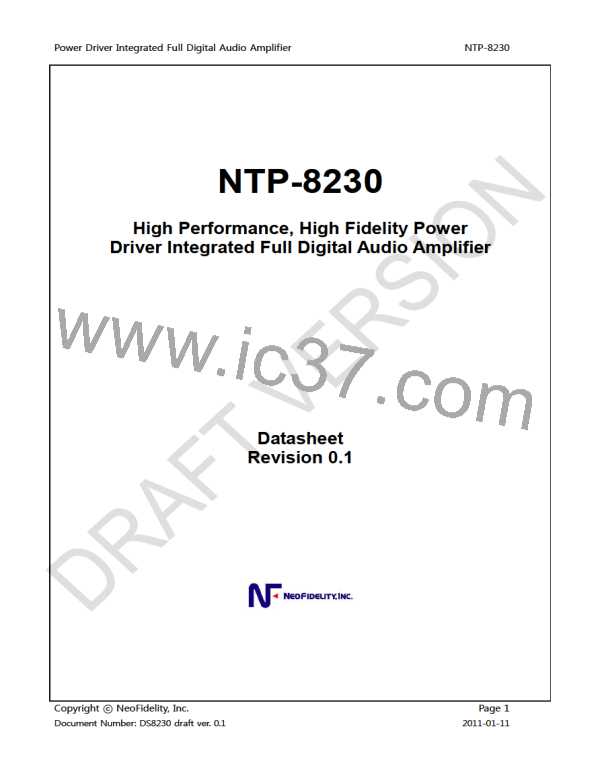Power Driver Integrated Full Digital Audio Amplifier
NTP-8230
For D-BTL mode, there are two additional parameters, which are MLP (Minimum Linear Pulse Length)
and MPC (Maximum Pulse Length to Compensate). MLP defines the minimum pulse length that can
guarantee a linear relationship between the input and output pulse length. Generally, the width of the
output pulse is proportional to that of the input pulse. However, as the width of input pulse becomes
narrower, such linear relation is not maintained due to the characteristic of a power device. The
minimum MLP value is preferred as long as linear relationship between the input and the output pulse
is satisfied. In addition, in terms of power consumption, a minimal MLP value is preferred.
MPC determines the width of compensation pulse. In other words, since a short-length pulse tends to
have non-linear relationship between input and output, an input pulse which has the equal or less
length of MPC is counterbalanced using compensation pulse. Whereas, an input pulse which exceeds
the length of MPC has no compensation. This compensation is illustrated in Figure 21, when the input
data is equal or less than the MPC width.
Data+MLP
Output A
Output B
Data
MLP
Figure 21. Compensation by MPC and MLP
11.5. Soft start
The soft_start reduces pop noise by controlling rapidly increased energy of PWM.
To begin soft_start operation, PWM soft start enable register (0x52: PSE) should be set to high, and
then PWM switching on/off register (0x27: POF) should be set to low. The duty ratio of PWM output
increases from 127:1 (Low:High) to 50:50 (Low:High). Step repeat time register (0x52: SRT) means
repeat number of PWM output. Soft_start operation with 17 repetitions is shown in the Figure 22.
HIGH
PSE
LOW
HIGH
POF
LOW
44.48us
HIGH
LOW
HIGH
384kHz
(2.6μs)
pwm_a
LOW
HIGH
180˚
pwm_b
LOW
17
17
2
126
1
127
40.6ns
(2.56us)
20.3ns
(2.58us)
Figure 22. Soft start operation timing
Copyright ⓒ NeoFidelity, Inc.
Document Number: DS8230 draft ver. 0.1
Page 24
2011-01-11

 ETC [ ETC ]
ETC [ ETC ]